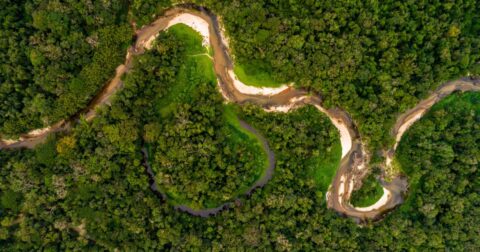Solutions
Eating Just 10% Less Meat Could Help Protect Drinking Water
Climate•6 min read
Explainer
Deforestation in the Amazon rainforest is now at a six-year low, but factory farming continues to drive destruction.


Words by Grace Hussain
The truth sounds unbelievable, and certainly counterintuitive, when talking about what should be the planet’s lungs: animal agriculture, logging, mining, infrastructure and urban development caused some parts of the Amazon rainforest to emit more carbon dioxide than it absorbs in 2021. Deforestation in the Amazon has eliminated thousands of species of wildlife and plants, put the lives of local communities at risk and crippled one of nature’s most important tools in storing carbon and staving off the climate crisis. According to the World Resources Institute, the Amazon rainforest remains a net carbon sink, just barely, and that’s thanks to strong protections in lands managed by Indigenous communities.
Let’s take a look at how we got here, and what can be done to restore this crucial rainforest.
Not only does the rainforest provide a habitat for thousands of species of wildlife and millions of plant species, but it plays an important role in counteracting global climate change. By current estimates, the Amazon holds around 150 billion tons of carbon, which would otherwise be released into the atmosphere in the form of carbon dioxide emissions.
The rainforest spans parts of Venezuela, Guyana, Suriname, Brazil, Bolivia, Peru, Ecuador and Colombia. Brazil contains the largest portion of this natural resource — just over 1.5 million square miles of the Amazon. Brazil is also where the majority of deforestation took place in 2021.
The world’s most well-known rainforest covers approximately 2.72 million square miles in total, equivalent to twice the size of India. The Amazon river that flows through it is 4,100 miles long.
Much of the Amazon rainforest remains unexplored — and its remoteness helps limit its destruction. In fact, the ancient ruins of vast cities were recently discovered in the midst of the forest.
Native wildlife flora and fauna are still able to flourish in the most remote areas, and Indigenous people are able to remain isolated. Researchers believe there are still several dozen communities of Indigenous people in the Amazon who have never been in contact with researchers.
Researchers believe mass deforestation began in the 1960s, driven by land owners and their commercial activities.
Large swaths of the Amazon rainforest have been slashed and burned to be used for intensive animal agriculture, crop production, mining and industrial development. By 2018 these activities, among others, had resulted in the deforestation of 17 percent of the Amazon. In the past 20 years, eight percent of the rainforest has been destroyed as it continues to lose resilience.
Cattle ranching is a leading driver of deforestation in the Amazon, accounting for around 80 percent of the destruction there, and the release of 340 million tons of carbon per year. The region has experienced an eight percent increase in cattle since 2020.
The cumulative effects of small-scale agriculture are also devastating the Amazon. Research suggests that an increase in the number of smaller-scale agriculture operations started across Amazonia between 2001 to 2014 are an effort by landowners to deforest while evading government monitoring systems.
Just like animal agriculture, crop production in the Amazon involves the clearing and burning of large areas of land. The crops grown on these areas of land include soy, sugar cane, palm oil, cotton and rice. Since soy is a key ingredient in animal feed, its demand is rising along with the global demand for meat.
In addition to the issues caused by the clearing of such vast areas of the rainforest, agricultural practices such as the use of pesticides and fertilizers have implications for the native wildlife, plant species and Indigenous people of the region.
Logging, including illegal logging, is another major culprit when it comes to deforesting the Amazon. Scientists were especially alarmed when they learned that logging is moving deeper into the rainforest instead of staying on the periphery, where it is more easily tracked and monitored.
The Amazon region is often mined for gold, copper, iron, manganese and other materials. In order to mine these materials, landowners clear vast areas of forest in order to dig mining pits. Gold mining is on the rise in recent years and, in one area of the Amazon along the Guiana Shield, gold mining accounts for around 90 percent of deforestation. The process of mining gold has further ecological impacts due to its use of mercury, which can contaminate local water supplies.
Increasing deforestation rates impede the Amazon’s ability to store carbon and counter climate change. In 2021, it was discovered that due to deforestation, parts of the rainforest started emitting more carbon than it held.
Our changing climate is also having an impact on deforestation. As the forest becomes drier and contains less moisture, it becomes more susceptible to wildfires, which themselves cause critical damage to the environment and biodiversity.
The development of road networks has made parts of the rainforest accessible that were previously difficult to reach. The majority of deforestation hotspots in Brazil in 2021 were found along major road networks.
When decision-makers have a simplistic pro-development agenda, they tend to have little regard for the devastating ecological and social impact of deforestation. Destructive activities surged in the Amazon after 2019, when president Bolsonaro’s government in Brazil weakened the protections that were previously put in place to protect the rainforest.
Fortunately for the planet, with the election of a new president, Luiz Inácio Lula da Silva, efforts to combat illegal deforestation and protect the rainforest have increased. Deforestation is now at a six-year low, in part as a result of those efforts.
The Brazilian Institute of the Environment and Renewable Natural Resources was set up to monitor activities related to the conservation of natural resources in Brazil. In 2019 and 2020, however, the agency acted on only 1.3 percent of the alerts for illegal deforestation activity in Brazil. Estimates suggest 94 percent of deforestation in the Amazon and the Cerrado may involve illegal activity, or around 18 million hectares of habitat.
Though Brazil’s new president is taking steps to remove cattle who are being kept illegally in the rainforest, ranchers, and even some politicians, are attempting to stop the operations.
Fires are often started deliberately in the Amazon to clear land for animal agriculture, crop production and other related activities. In addition to intentionally destroying thousands of hectares of the rainforest, fires can easily escape control.
While the natural moisture of a rainforest should provide protection from the spread of fire, increasingly dry conditions can impede the rainforest’s ability to protect itself. Wildfires clear even more areas of land, and in turn, increase susceptibility to further fires.
Deforestation is impacting millions of people who live in the Amazon, including Indigenous communities. While there has been much debate over how far pre-Columbian societies altered the landscape of the Amazon, one study published in 2021 suggests that native inhabitants of parts of northeastern Peru have lived there for thousands of years with very little impact on its ecosystem.
Through a process known as transpiration, the Amazon expels large amounts of water into the atmosphere. This water then falls as rain, providing around half of the region’s rainfall. he health of the rainforest and its trees contributes to this process and helps to maintain a functioning water system. If too much of the Amazon is deforested, this natural balance is also in jeopardy.
With a reduction in the number of trees, the Amazon has less cover, contains and releases less moisture and can no longer cool the local climate in the way it once did.
In order to protect the Amazon rainforest, and thus ourselves, it’s necessary to take a multi-faceted approach that engages governments, NGOs, local and Indigenous communities, and nature itself.
Brazil’s previous president, Jair Bolsonaro, not only failed to enforce laws protecting the Amazon rainforest, but also cut the budgets of the government offices responsible for protecting it. Despite these moves, he did sign onto an international agreement to end deforestation.
His successor, President Luiz Inacio Lula da Silva, has taken steps to meet those goals, and made protecting the Amazon a central part of his environmental platform.
Amazon — the corporate giant, not the rainforest — launched a program in 2021 to support nature-based solutions in its namesake. They provide funding and technical support to small-scale farmers who opt to take part in sustainable, plant-based agriculture rather than expanding cattle operations. In exchange, the online marketplace receives carbon credits for the additional carbon being removed from the atmosphere and stored in the farmers’ trees. Carbon credit programs, however, are only successful when the removals are real, additional, permanent and measurable; yet a recent investigation published in The Guardian revealed that 90 percent of certified rainforest credits were worthless.
There are numerous nonprofits involved with preserving and reforesting the Amazon rainforest. Some of the bigger names are The Nature Conservancy and Conservation International. There are also numerous smaller, locally run and organized groups.
Since cattle ranching and feed crop cultivation are the leading causes of deforestation in the Amazon, reducing or eliminating the amount of beef and dairy we consume is a key part of protecting the rainforest.
Indigenous peoples have lived alongside and stewarded the natural resources of the Amazon Rainforest for thousands of years. Under their watchful eye, the rainforest thrived, and they continue to advocate on the forest’s behalf.
As one of the most biodiverse places on earth, the Amazon is home to thousands of different species. Its destruction has lasting implications for all who call it home. When the forest is destroyed, animals lose their homes and food chains are disrupted, leading to species extinctions.
In just 50 years, almost 20 percent of the Amazon rainforest has been destroyed. Scientists warn that we’re dangerously close to the forest’s breaking point: 25 percent deforestation. At that point, the forest risks collapsing in on itself and transitioning to scrubby savannah.
Just over 80 percent of the rainforest coverage measured in the 1970s still remains. Of that, scientists caution that 38 percent suffers from some sort of degradation. Yet recently, much of the deforestation has been halted as a result of more protective environmental policies.
Environmental advocates are using a number of different tactics to protect and restore the Amazon rainforest. Some point to carbon credits to encourage corporations to invest in the forest’s protection whereas others are encouraging stronger public policy solutions, especially regulations that limit agricultural expansion. Still others take a more grassroots approach to bring attention to the issue and protect the forest.
The largest driver of deforestation in the Amazon is animal agriculture. Roughly 80 percent of the deforested land has been converted into pasture land for cattle. The country driving the trend is the United States, which in 2021 bought more than 320 million pounds of Brazilian beef.
The Amazon rainforest is one of the planet’s critical tools for staving off the climate crisis. Yet some parts of the forest have already started emitting more carbon than they absorb — a trend we can’t afford to perpetuate.
Research suggests that reducing or eliminating consumption of beef; especially that from JBS, the largest Brazilian beef company, has the potential to halt global deforestation, including in the Amazon rainforest.